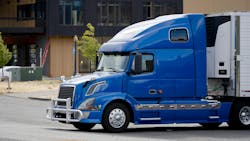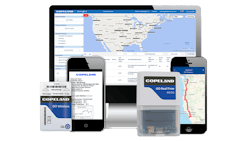Shipping meat and seafood within the perishable cold chain is a high-stakes proposition for grocers, restaurants, and their supplier networks. Temperature abuse can lead to the formation of bacteria and the potential for foodborne illness. Protecting consumers from this possibility is the top priority. In addition, stakeholders must guard against financial losses from rejected loads, legal entanglements, and reputational damage.
Proper refrigeration and robust temperature management programs are the foundation of quality assurance (QA) initiatives. In particular, temperature consistency is critical to help prevent spoilage and the growth of microorganisms.
Temperature issues can harm every stakeholder in the cold chain.
Consider the following scenario for a typical grocery or restaurant QA team.
A load of beef arrives at the local distribution hub a few days before the Fourth of July holiday weekend. Although the refrigerated trailer temperature is still within the high end of the acceptable temperature range, the QA staff notices several red flags of temperature abuse:
- Pulp temperature readings are slightly above the safe maximum temperature for beef.
- The product packaging contains an excessive purge of blood and moisture, suggesting that some thawing and/or warming occurred.
To confirm their suspicions, the QA staff checks the trip data from the onboard data logger. They discover that the trailer holding temperature rose to 47 degrees Fahrenheit for more than four hours earlier that day—well above the safe range for beef. This could indicate several possibilities:
- The driver turned off the refrigeration unit, likely to save on fuel consumption and expenses.
- In a multi-drop load scenario, the driver may have left the doors open too long while dropping off other products before this delivery.
- A malfunctioning reefer unit
- Insufficient trailer insulation
- Air chute issues
Whatever the cause, the QA staff is left with no other choice than to reject the load, which may be valued at more than $100,000.
Even though the customer doesn’t end up paying for a bad load, the product loss results in opportunity costs. A grocer may suffer lost revenue and empty shelves until the next load of beef arrives—which could be up to a week. If the client is a restaurant, it could potentially take one of the most profitable items off their menu during the holiday weekend, disappointing customers and indirectly encouraging them to dine elsewhere. The incident will also weaken the food supplier’s relationship with its customer. The supplier must scramble to replace the lost product in time or risk losing business to a competitor.
Of course, the next step in this unfortunate scenario is to determine the parties responsible for the product loss.
Cold chain safety is a shared responsibility
Producers (shippers), carriers (truck drivers), logistics companies, distribution centers, and retailers all share responsibilities when it comes to ensuring cold chain safety. The potential for temperature abuse of meat and seafood can occur at any phase of the shipping process, especially whenever product changes hands.
It’s critical for stakeholders to understand the regulations governing the meat and seafood industry cold chain, follow shipping best practices, and take preventive measures to promote food safety.
Federal guidelines and regulations
Depending on the product, the distance from its origin to destination, and its intended use, various commodities are shipped fresh, frozen, or somewhere in between.
Per recommended guidelines from the U.S. Department of Agriculture (USDA), proper refrigeration during transit is necessary to address food safety concerns and preserve the freshness of highly perishable meat and seafood. These standards are intended to help minimize the potential growth of harmful bacteria and microorganisms, preserve the fresh physical appearance and necessary hydration levels for quality, and maximize the useful shelf life.
USDA guidelines recommend specific temperature ranges for various types of products, with optimum ranges allowing little room for deviations. In addition, the Food Safety Modernization Act (FSMA) authorizes the FDA’s requirement for producers to specify the required temperature range for each perishable shipment.
If a carrier is suspected of temperature abuse or deviating from the standard, they are responsible for verifying proper holding temperatures were maintained during transit while the product was under their purview.
Use of third-party temperature-monitoring devices—such as real-time trackers and loggers—is the most effective way to automatically and effectively capture this data. Without this information, carriers can be at risk if a temperature abuse dispute occurs. Discharge and return-air temperatures from the trailer’s refrigeration unit may not be admissible by courts in every state. By contrast, third-party monitors provide an objective record of shipping conditions.
Nuances and best practices
For meat and seafood stakeholders, effective temperature management requires careful attention to a full spectrum of perishable shipping processes and best practices.
- Product and trailer preparation establishes a temperature baseline.
Before shipping, product is packaged fresh or frozen and loaded into a refrigerated trailer that is pre-cooled to a specified temperature range. The insulating effect of boxes and packaging makes it imperative that both the product and the trailer are at the desired temperature when packed, stacked, and loaded.
Once product is loaded, it’s too late to try and cool it further. The trailer and its refrigeration unit aren’t designed to remove unwanted heat or pull temperatures down to desired ranges. Make sure the refrigeration unit is set for continuous run mode for the duration of the cold chain journey.
- Maintain proper holding temperature ranges in transit.
Because they are designed only to maintain proper holding temperatures, refrigerated trailers should be thoroughly inspected before each shipment. Check for tears in the walls and insulation—especially considering the abundance of older trailers on the road today, which can have degraded R-values. Ensure sufficient airflow and proper operation of the trailer’s air chute, if present, and verify proper door sealing to create a refrigerated compartment.
Meats are porous and can absorb odors, which could result in spoilage or poor product taste. To help prevent this, clean, sanitize, and deodorize the trailer to help protect against potential cross-contamination with previous loads. Don’t mix loads with other odor-emitting products.
Load, arrange, and stack product and pallets to help reduce heat transfer from the exterior walls of the trailer to the payload. Follow a centerline pattern to support proper airflow and avoid over-stacking meats, which can cause unwanted purges. Ensure temperatures are consistent from the front to the back of the trailer.
- Understand the shipping method.
Freight on board (FOB) shipments fall into two categories, and it’s important to be aware of the differences between them.
-
- FOB Origin: The buyer assumes ownership of the goods when they leave the seller’s facility. The seller still has a stake in the quality, however, as this impacts their brand’s reputation. The purchaser also cares in this scenario because they have financial ownership of the product. In the event of loss, they would have to work with the carrier and insurance provider to determine who is at fault.
- FOB Destination: The shipper retains ownership of the goods until they’re delivered. The seller’s stake in the cold chain is higher in this scenario because ensuring the quality of the product upon delivery is their responsibility. The purchaser benefits from detailed temperature data; they wouldn’t want to accept product that’s suffered temperature abuse and would therefore have a shorter shelf life.
Consumers don’t know or care who owns the shipment at any given point. But the quality of the food they eat matters a great deal, and they’ll ultimately blame the brand if the product doesn’t meet expectations.
- Shipment size considerations
Full truckload shipments with only one pickup and drop destination are less susceptible to temperature deviations caused by doors opening and closing. This option provides the most predictability and relatively fewer risks, regardless of the shipping method.
Partial truckload shipments typically fill more than half of the trailer but leave room for another company’s product as long as it’s being delivered to the same destination. Although this can save shipping costs, it comes with some risks. Product from the other company may be loaded at a different temperature range. In addition, cold air can escape during loading or unloading, potentially leaving product susceptible to heat for an extended period.
Less-than-truckload (LTL) is a designation for smaller shipments, typically handled with a “hub-and-spoke” model. One truck picks up the shipment, which is consolidated at a third-party facility and loaded onto a different truck for delivery. This multi-leg supply chain adds more risks because multiple refrigeration units need to be operating correctly.
LTL loads can take longer to build. This can extend the time required to maintain proper shipping temperatures. It can also result in poorly arranged loads that negatively impact airflow, stacking, temperatures, and food quality.
No matter the size of the shipment, multiple stops for pickups and deliveries introduce more opportunities for opening doors during loading and unloading, and ultimately, more risk of temperature abuse.
Monitoring and managing cargoes with third-party temperature controls
In the meat and seafood cold chain, proper measurement can only be accomplished with robust third-party monitoring capabilities, which provide the means for validating temperature data with objectivity and urgency.
An ideal solution is comprised of integrated hardware and software, including:
- Real-time tracking devices that leverage cellular networks to provide live location and temperature information
- Data loggers that provide a history of in-transit temperatures after a shipment arrives
- Cloud-based software that can aggregate shipping data into a centralized platform and transform it into deep cold chain insights and intuitive dashboards
Real-time trackers are ideal for those seeking a proactive approach to temperature management or who need to track delivery arrival times. Stakeholders are alerted precisely when and where temperature abuse is occurring, enabling them to take immediate action to prevent loss, rather than waiting for a shipment to arrive. Location data can help users anticipate delayed shipments, making it possible to reroute trucks or take other precautions to help prevent supply disruptions.
Historic data loggers provide an objective record of in-transit temperatures, which can be downloaded upon receipt of the shipment at a facility. This objective record provides evidence of any temperature abuse, which can be used to make more informed decisions about whether to accept or reject loads. They’re also valuable resources when resolving claims disputes. Since data logs can’t be tampered with, they’re admissible as evidence in a dispute.
Cloud-based software combines all data streams into one location. This helps provide complete visibility into current cold chain activities while uncovering historic performance trends. Consolidated data enables more informed decision-making while assisting users to create preferred carrier lists and improve perishable temperature management.
Dan Knauer is an account executive with Copeland’s cold chain cargo solutions team. He’s been with the company for eight years, previously serving as a business development specialist and regional sales manager.
About the Author

Dan Knauer
Dan Knauer is an account executive with Copeland’s cold chain cargo solutions team. He’s been with the company for eight years, previously serving as a business development specialist and regional sales manager.


